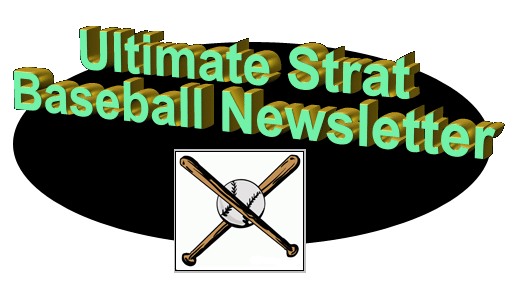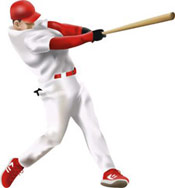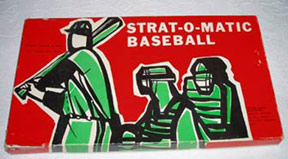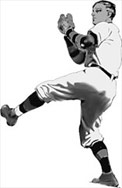Vol. IV,
Issue #4 - May 2016
**
Welcome to
"The Chuck Stop"
with Chuck Tinkler
**
Diamond Vision: Tales of a Strat Master (Part IV)
(We welcome you to this new periodic area of our newsletter that
is known as
"The Chuck Stop"
which will
feature one of our favorite contributors, Chuck Tinkler.
Our boy Chuck returns to conclude
his epic article with sections VI & VII of his
tale and experiences with a special
individual he has met that
was very knowledgeable about
the game ... a true Strat Master he says? Continuing reading on
... )
Comments from the Wolfman:
We wish to thank Chuck for
yet again coming up with the final part of his fascinating
article for the Ultimate Strat
Baseball Newsletter. We have decided to collect all of his
articles into one place here, now known as
The Chuck Stop. In this edition, he finishing his
fascinationg story about his experiences with an individual who
Chuck has referred to as the "Strat Master". Going
forward we expect to see other articles from Chuck as he
periodically entertains us with his views on Strat. Chuck
always likes to chat about Strat, of that there is
no doubt, dealing with Hal settings and
ballpark dimensions in particular. So feel free to email our boy
Chuck
with your questions or comments related to this article. His email
is listed at the end of this article. Thank you for your contribution
again Mr. Chuck!!
To read any of the previous articles which Chuck has shared with
our newsletter since 2014, you will find them listed below. If
you haven't read the earlier parts of this article on the "Strat
Master", first go to the November and December 2015 editions
plus the previous edition we shared this past February. See all of Chuck's earlier articles
listed below.
http://www.ultimatestratbaseball/USBN-10-2014/CharlesTinkler-September2014.htm
(his first article for our newsletter about Ballparks - quite
insightful, check it out)
http://www.ultimatestratbaseball/USBN-11-2015/CharlesTinkler-November2015.htm
(This is the link to Part I
of this article about the Strat Master with Sections I & II) )
http://www.ultimatestratbaseball/USBN-12-2015/CharlesTinkler-December2015.htm
(This is the link to Part II
of this article about the Strat Master with Section III)
http://www.ultimatestratbaseball/USBN-2-2016/CharlesTinkler-February2016.htm
(This is the link to Part III
of this article about the Strat Master with Sections IV & V)
 Diamond
Vision:
Diamond
Vision:
Tales of a Strat Master
(Sections VI & VII)
The Final
Report on the "Strat Master"
VI
Okay. So enough with dancing around the subject. Secrets were
promised and it's time to deliver.
Let's say that greatness comes in the form of a pyramid. That
is, those at the top are fewer in number than those at the
bottom. In terms of MLB players, let's say that there is only
one centerfielder like Mike Trout, a few guys that are kinda
close, several guys that are kind of close to them, numerous
guys that are kind of close to them, and an infinite amount of
players that are average/replacement level or below. And let's
establish the difference between a great player and a great
season: a great player repeatedly produces great seasons; great
seasons can be had by other than great players. Additionally,
let's say that teams have two ways of acquiring resources: draft
and trade. Some leagues have minor leagues systems, free agency,
etc.; for our purposes here though, only draft and trade will be
considered. Lastly, let us separate this as a conversation about
having a great team as opposed to "winning". What "winning"
means to some may be different than to others and is beyond the
scope of this article. For our purposes here, let us focus this
piece on strategies behind creating a great team.
As
said before, leagues are filled with different GM's, each with
their own style, approach, perceptions, etc. Some like to play
for this or that, to have their hometown guys, see how many
bases their team can steal, whatever. Most guys are trying to
"win". Approaches to winning though are as varied as the GM's.
Some wait for "their year", some patiently accumulate, some go
for broke every once in awhile, etc. As for Phil, this was about
creating the greatest team a human could create. It was about
winning, yes, but the prelude to that was getting the guys that
were fitting enough for someone who had the lofty standards for
themselves that he had. He didn't want one-year cards, etc.; he
wanted a team he can beat your brains in with forever.
This is a critical distinction because in every league are there
GM's doing this and doing that, placing value on players that he
wouldn't and not properly valuing the ones that he would. While
everyone was busy trying to "win", he was busy trying to end
their lives as they knew it - the underbelly of draft leagues
that nearly all are susceptible to.
The
way this would play out traces back to the basic pyramid
structure described above. At the top of the pyramid there are
great players - guys who can produce outstanding seasons,
repeatedly. At each position is there usually then a truly great
player(s), more numerous "very good" players below them, even
more numerous "good" players below them, and on down the line.
When guys are trying to "win", they don't necessarily need great
players, they can do it with a mix of great players and great
seasons, or in some cases, just a healthy dose of great seasons.
And truth is, many GM's don't even know the difference between a
great player and a great season (or a bad player and a bad
season). At least, in every league are there guys that either do
not know or do not care. The point here though is that there are
many ways to win, but there is only one way to dominate: have
all the great players.
So
what this really was then is just a big shell game. Let us label
each tier of the greatness pyramid with a letter: A is for guy(s)
at the top, B is the next tier, C is the next, and so on. Phil
needed A's at every position to do what he was trying to do.
Other guys didn't need all A's to do what they were trying to
do. Furthermore, as said, a lot of them didn't even know the
difference anyways - they'd become enraptured by a good season
and totally distraught when struck with a bad one. The whole
trick for him then was as simple as convincing the other guys to
give him their A's will he handed off B's, C's and whatever else
he could get rid of. And the whole thing worked because he knew
the difference between an A and C and there were always guys
that didn't - so it just became was a game of finding the weak
link(s) in the league, dangle an irresistibly great season in
front of them, walk off with the goods. Simple as that. Do that
or a myriad of other things that more or less produced the same
result.
Simple as that, but not actually quite that simple. To do this,
Phil needed a steady stream of B's and C's to fuel his machine.
Every draft, while guys were doing whatever they were doing, he
was on a mission to use every pick to either draft a great
player (or player that could be great) or draft pieces that he
could bait someone else with later. Nothing else factored in. He
had a singular focus - he concentrated his strategy into
something of a laser that he could slice through every draft
with. While other GM's were wavering about this guy or that guy,
he had a profile in mind for what he wanted every one of his
picks to be, and drafting for him was just a matter of
identifying those guys and pulling the trigger when they stepped
in front of him.
If
Phil were ever to become convinced a player wouldn't achieve the
utility he had sought, out they went. They became a 'B' or 'C'
in his mind and earmarked for expulsion. In this way, every
draft had the same conclusion for him: he came out of it with
great players, one way or the other. He could work his scheme
from the back of the draft as easily as the front. He just had
to keep himself from being distracted by the imposter players,
which he never was, and the train just kept on rolling.
For
this to work though, Phil had to be able to do what for some is
impossible: trade anyone, anytime. Many guys think they can do
that, but when push comes to shove, they get cold feet. For him
though, he had his system, he trusted his instinct, and when he
saw a chance to move up the pyramid, he'd pull the trigger,
regardless of the names involved. And really, for the system to
work, he had to be that way - getting caught holding the bag on
these guys spelled nothing short of catastrophe in his mind. So
just as soon as one tumbled out of their lofty perch, out they
went. And just as well, as soon as a guy turned in a season over
their head, out they went too. He of course would act like he
was trading away nothing other than pure gold, but he wanted to
get rid of these guys even worse than the guys that were on the
downhill slide. Usually when GM's have great seasons dropped in
their lap, they think, "Wow, I'll get to have him here, doing
this…it'll be great!". Phil had the exact opposite reaction. He
didn't want great seasons - only great players. So as soon as he
had a great season dropped in his lap, he'd load it into the
muzzle of his gun and go hunting for some sucker to blast with
it. (And one would pop up, seemingly each and every time.)
VII
As
said, draft leagues are full of guys who play for different
reasons. They are full of guys who play for different reasons
and who have varying skill levels. For a lot of guys it takes a
real effort just to survive. So when a guy like Phil comes
along, with three very good players at positions that are
critically needed, and even offers to take some piece of garbage
back all for just this one, special guy he wants…it's easy to
get suckered in. And from his willingness to do this over, and
over, and over again, that or lay some other trap to step in, it
wouldn't ever take but a year or two before he was up and
running and three or four years before he was straight
dominating. He had his formula, he stuck to it, and everyone sat
around, scratching their heads, saying "how does he get so
lucky??", when in truth, it was them who enabled him to do it.
For
every Superman though is there Kryptonite. For Phil, it was
technology. The face-to-face league became a play-by-mail league
and he was slow to adjust to the computer age. Going to PBM
(play by mail)
broke the personal connections, and for him, it just wasn't the
same. Running his scheme required emailing guys, guys he didn't
know, guys who seemingly came and went, guys who were in so many
leagues that they wouldn't even bother responding, and it just
aggravated him to no end. He would always say "Why can't anyone
pick up the (dang) telephone anymore?!". The whole situation
left him with just me and another buddy to deal with, and we
knew darn well that if Phil wanted to do a deal, we shouldn't.
With his blood supply effectively shut off, he was left with
just the draft, and a team can only last so long with having
nothing but the last pick to work with. His teams crumbling and
computer problems growing in annoyance, he just checked out. It
just wasn't worth the hassle anymore. If anything, his great
success had caused the league to become bitter and resentful
towards him and all of it just kind of combined to overcome any
interest he had in continuing. We tried to get him going in some
other leagues later and he said "two years…I'll win…who cares"
and just kind of trailed off. He was done.
Final Thoughts
While this all sounds fine and dandy, it took an amazing amount
of baseball knowledge on his part for the whole thing to fly.
Phil pitched in the minors and coached another 30+ years after
that, so he knew what he was looking at when he saw a ball
player. He could take one look at a fastball, curveball, a
batter's swing, and he knew. Every time he had a deal in place,
a draft pick to make, a decision to make, he always had that to
fall back on - he could conjure up in his mind a picture of the
guy, watch a highlight, read a stat line, and he just knew.
There is simply no substitute for that; it is something that no
draft list, website, or book can ever provide. Phil too had been
playing Strat-O-Matic since the 1960's and for that too was
there no substitute. He knew the nuances of the game, knew the
X-charts, knew what defensive ratings meant, what hit-and-run
charts did, what steal ratings meant, all of which conferred a
huge advantage when playing someone FTF.
Last but not least, Phil was a brilliant strategist. His ability
to envision a path to greatness, and a desire to see it through,
were far beyond all else in making the impossible a reality.
Chuck Tinker
(FINAL NOTES from the WOLFMAN:
We want to thank Chuck again for concluding another one of his
classic articles for our members. We can't wait
to see what his next contribution will be here at "The Chuck
Stop". Again, we are always open to new ideas and
submissions by our members and perhaps (we hope) that Chuck has
been ain inspiration that you might consider to
send to us one of your own offerings. As stated before, Chuck as
always is up for chatting about Strat, reach him at:
chucktinkler@yahoo.com
)
|
Support the Cause
If you are enjoying
the content and information our newsletter shares with you, why
not support us with your helpful donation for our minor expenses
and time?
|
Contained inside this exciting issue of Ultimate Strat
Baseball Newsletter:
(to view the various interviews, articles, columns and special sections click on
the links {underlined}
and this will take you to the appropriate
webpage)
♦
RETURN TO NEWSLETTER MAIN PAGE
♦
INTERVIEW with
DON AUGUST,
Ex-MLB Pitcher, Don August was a pitcher for the Milwaukee
Brewers for four seasons. He talks with the Wolfman about his insights on the
game of baseball and what
experiences he had during his major league career, as we
continue to interview more ex-MLB players, those who we recognize
their names from their Strat-o-matic cards in past seasons.
♦
ARTICLE with MATT EDDY, Matt
returns with his first article for USBN discussing ten keys how
to set your playoff roster. Matt is a key editor for
Baseball America as well as helps his SOM baseball league with
their blog and website.
♦
INTERVIEW with BART EWING,
Bart Ewing an old friend of the Wolfman's, from the 1970
National Convetion days talks about the art of doing
personal replays and what he calls his "Championship
Leage" battles in this interview.
♦
ARTICLE with WOLFMAN
SHAPIRO, Wolfman
takes a good hard look at the new "Baseball Daily" game play
with SOM Baseball as he decides to manage the 2016 Chicago Cubs
day by day. He discusses how this new level of the
computer game works.
♦
SOM BASEBALL LEAGUE REPORT with WOLFMAN SHAPIRO
--
the editor of "The Ultimate Strat Newsletter" and 2012 CBA
Champion, talks to members of various Strat-o-matic
Baseball Leagues that he has discovered on the internet about
the history of their league and their experiences. This is the
first time we get to speak to a League Commissioner of a
Baseball Retro League and how these leagues are different than
the normal draft league. To read the interview, click on the link below:
INTERVIEW with Vinny
Manchini, EGML Commissioner, P-VII (Computer)
♦
BASEBALL BOOK REVIEW with WOLFMAN SHAPIRO
, editor of "The Ultimate Strat
Newsletter" takes a peek at the 2016 Prospect Handbook published
by Baseball America and tells you why this book is needed for
SOM League Managers using the latest card sets.
♦
RECOMMEND
ON-LINE SOM RESOURCES
--
On-line Strat-o-matic and Baseball related websites
that offer amazing information, special tools and products to improve
your game play
that we strongly recommend. In most cases, we have had personal contact with
these sources who agree with the principle to work together and help promote each other.
♦
BOOKS TO
DIE FOR and Become a BASEBALL GURU
-- This page
is
specifically about special books we are finding that either will
expand your insights about the game of Baseball, help you in the
creation of your current league teams or with your replays and
learn more about the Strat-o-matic
Baseball Game and Game Company's
history. We
have a special arrangement with Acta Sports, who is a publisher
of a number of great baseball books (including Bill James
Handbooks) to offer for our members
a 10% discount. We will continue to add more books to this page in the future
as we uncover other gems our members should know about.
Contact Us for Questions or Submissions:
Wolfman Shapiro
Founder/Editor, the
Ultimate Strat Baseball Newsletter
email:
wolfman@ultimatestratbaseball.com
facebook:
www.facebook.com/wolfman.shapiro
twitter:
@StratBaseball4U




